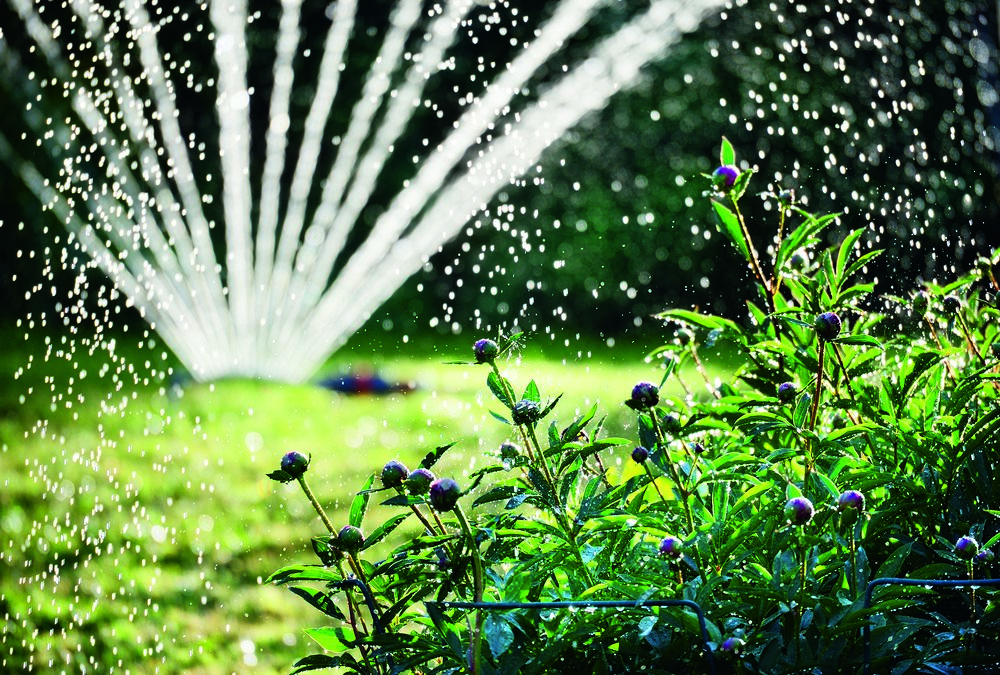As I write this piece, we’re in the middle of a heatwave and looking at the possibility of hosepipe bans in some areas. So once again, it’s very difficult to judge which way to go with advice with plants without the aid of a crystal ball!
However, we’ll start with some basics on watering, though they may not be relevant by the time you read this – it might be pouring down with rain! Never water or spray chemicals onto plants during hot sunny weather – if you do, scorching becomes a major problem. Water very early in the morning or late at night to avoid this. Water greenhouse plants in the morning to avoid moisture lingering on plant leaves and causing disease. Keep greenhouse doors and vents open even at night to allow good air circulation.
Soggy bottoms?
Although plants need plenty of water in hot weather, some don’t take up water so quickly and can soon become waterlogged – fuchsias are a prime example and are better situated in the shade if possible. If you’re getting blossom end rot on tomatoes (leathery brown patches at the base of the fruit), try watering with Vitax Calcium to correct the deficiency of calcium, which causes this problem particularly in hot weather.
The range of perennials available from garden centres for late summer/early autumn flowering is increasing year on year. Heuchera have lovely coloured foliage all year round from lime green, through copper and bronze and the lovely purple shades many with prominent leaf veins which make a lovely contrast. They’re easy to grow – ideal in sun or semi-shade and not damaged by slugs and snails.
Another pretty summer/early autumn flowering herbaceous plant is the monarda – they have pretty whorls of pink or scarlet flowers on stiff stems, and usually grow around 1m tall, but we have had varieties in this year which grow to just 30cm. Another one to look out for is echinacea with their brightly coloured flowers and prominent centres. Buying perennials from spring through to autumn will give colour for many months of the year.
Early harvests
In the veg patch, start to harvest onions and potatoes now – lift up onions and allow to dry out where they’ve been growing if the weather is fine, before storing. Potatoes should be stored, preferably in hessian sacks, in a cool but frost-free environment. Carrots and
parsnips can be left in the ground until needed. Continue to pick runner beans and courgettes regularly so they don’t become stringy and tough. Any green waste can be put onto the compost heap – both Scotts and Vitax do a compost activator that will speed up the process. It usually takes 12 months to rot down green waste into a usable compost.
Overwintering onions, shallots and broad bean seeds will soon be in stock; plant them as soon as you can and you’ll get an early maturing crop next year. Winter vegetable plants will arrive from the end of July onwards – cabbages, sprouts, broccoli, lettuce – so there’s no excuse for an empty veg plot in the winter.
Top tubs
Summer baskets and tubs should still be in their prime through September and possibly into October if we don’t get any early frosts, but as the nights draw in and the weather gets cooler, they’ll begin to fade. Once your baskets have finished, why not replant for winter colour; there’s plenty to choose from – pansies, violas, polyanthus, heathers, ivies and don’t forget to add a few spring flowering bulbs for added colour. You can also add small shrubs including gaultherias, leucothoe, skimmias and grasses.
Replant cleared borders with winter pansies, violas, sweet williams and wallflowers. Hopefully our own field-grown wallflowers will be available from the end of September, depending on whether we had some rain in July! Flowering in the spring with the bulbs, they have a lovely perfume. Spring-flowering bulbs should be available from August Bank Holiday; most can be planted as soon as you get them, but tulips can be planted later – through into November if weather is mild. When planting in tubs, put several layers of bulbs in first, starting with daffodils, then the smaller bulbs and finally plant pansies, violas or wallflowers last. You’ll get a longer flowering period in the spring and full pots.
Brilliant bulbs
Buy prepared hyacinth bulbs for Christmas flowering and plant them in bowls with bulb compost by mid-September. Bulb fibre contains charcoal which helps to keep the compost ‘sweet’ while the bulbs are in the dark. Give them a drink and put in a cool, dark place, bringing gradually into the light and warmth once the shoots are around 3cm high.
Clean out greenhouses before putting in overwintering plants and insulate with bubble wrap, and check over heaters ready for the first frosts. As you bring in plants to over winter, watch out for vine weevil larvae, especially on fuchsias. If you do see signs of them, drench the compost with Vine Weevil Bug Control from Bayer. If you prefer to garden organically, try the nematode steinernema kraussei in early September when the soil is still warm enough for the nematode to be effective.
Happy gardening!
This issue’s tips are provided by Ann Winwood of Lealans Garden Centre, Shipley.






